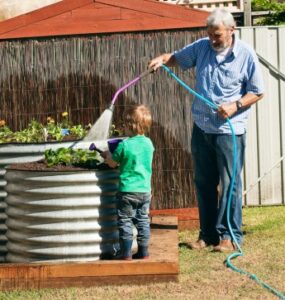
Joshua’s Garden
Don Burke shows how he built a raised garden bed so his two-year-old Grandson Joshua could launch his vegie-gardening career.
Growing vegies in raised garden beds is probably the easiest and best way to grow them. We purchased some organic garden soil and used an expert to inspect the pile first for suitability. The mix was also checked for worms as an indication that it was ready to plant in.
It’s also a good idea to have an OH&S expert check out safety aspects of barrowing the soil into place. A lightweight tamper was then used to gently settle the soil in the raised beds. Larger tampers would not do a good job as they might crush the soil. The two-year-old tamper was just right.
Pink-flowering strawberries were planted to provide lots of fruit, and the area around the strawberries was sown with dwarf sugar snap peas. These peas are eaten pod and all, but taste far better than snow peas.
The larger raised garden bed was planted with Asian vegies such as pak choy, Chinese cabbage, purple pak choy and Chinese broccoli (kailaan). We also planted various-coloured lettuce and coriander plus dwarf marigolds to repel pests. Watering in of seeds and seedlings was done with a hose and a watering can.
Note that the raised corrugated metal garden beds have been surrounded by ACQ treated pine railway sleepers for ease of access and also to finish it off neatly.
Don’s tips
Crowd control: we planted the seedling vegies at half the distances apart that are recommended. That is, twice as many as the instructions recommend. When the vegies are half-grown, we will harvest every second plant to eat and also to provide space for the remaining vegies to grow.
Feeding: use an organic liquid plant food every two weeks. You can make your own from chook poo such as pelleted chicken manure and water.
Thieving: theft of the fruit from strawberries and the sugar snap peas is common. Apparently young marauders steal and eat the fruit on the run. This is best ignored, perhaps even encouraged.
Raised bed tips
Growing vegies in raised garden beds has a lot to recommend it. All plants grow better in raised garden beds of any sort. Raised garden beds allow for perfect drainage and good air movement around the plants in them. With raised vegie gardens:
• The vegies are far easier to look after, cultivate and harvest.
• You are far less likely to injure yourself on stakes or by treading on nails in bits of wood, etc.
• It is easier to plan crop rotation.
• You can observe insect pests far easier, because you can see under the leaves where pests hide.
Calculations
For round raised garden beds like we have here, the volume of soil required is calculated by the area of the circle (π x r2) multiplied by the height of the bed (π = approx. 3.14). For example, the larger the raised bed had a diameter of 140cm, thus the radius is 70cm or 0.7m. And the height is 85cm or 0.85m. So the volume of soil is 3.14 x 0.7 x 0.7 x 0.85 = 1.3m3 (cubic metres).
You can get a rough calculation by treating the circle as a square. Thus the circle is treated as a square with sides of 11.4m. So the volume is 1.4 x 1.4 x 0.85 = 1.7m3 (cubic metres). It is always useful to have a little extra soil.
Equally, you can treat an oval-shaped raised bed as a rectangle for calculation purposes.
If adding extra organic matter (eg, horse manure) you would have to adjust the amount of soil ordered.
Our beds
Our raised garden beds were from Tankworks – www.tankworks.com.au
The larger bed, 140cm diamter x 85cm high, is $295. Raised garden beds are also available at Bunnings stores.


